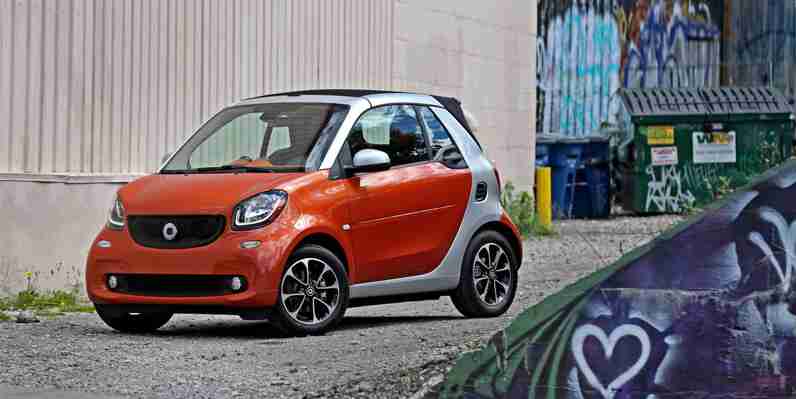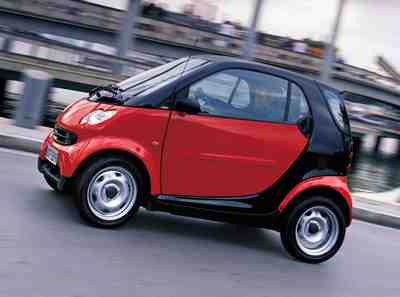How the Smart Car Works
9 Smart Car Technologies We Want to See (A Geek’s Wishlist)
(This article was originally published on 7th of July 2012.)
For a long time, the sole purpose of a car was to take us from point A to point B as fast as traffic conditions would allow us to. However, rapid advancements in technology has led to a surge in demand from many of us – we wanna have more comfort, entertainment, functionalities, and so on in our cars than ever before.
In that vein, we have come up with a wishlist of the things we would like to see (from a geek’s perspective) in cars of the future.
Just like how phones have evolved into smartphones, perhaps cars should also take a similar route and evolve into ‘smart’ cars equipped with futuristic and (more importantly) practical features.
In fact, some car manufacturers have already implemented a few of these things that we’re about to mention, but it’ll be nice to see them become standard features in all cars of the future.
1. Enhanced Gesture Control
Building on the familiar existing technology of knob and voice controls, Audi, in 2011, introduced a new feature that would provide unprecendented ease in controlling a car’s functions.
The new feature is called MMI touch, and is actually an enhancement for their already exisiting Audi Multi Media Interface (MMI) system.
The best thing about MMI touch is that it enables drivers to input characters just by using a finger to "write" on the designated touchpad. This has a wide range of applications such as keying in addresses for navigation purposes, entering phone numbers or simply selecting songs to play.
MMI touch also has support for a range of languages besides English.
Image Source: Mercedes Benz
Of course, the usual knob and voice controls are still available as well – MMI touch just makes it a whole lot easier for you to access your car’s functions while you’re driving.
And more recently, Mercedes-Benz has also introduced their own take on this enhanced gesture control concept.
2. Augmented Reality Head-Up Display
Having augmented reality display on a car windscreen would add a lot of functionality to the car. We would be able to see information like speed, navigation details and even the name of an incoming call with minimalistic designs on our windscreens.
Image Source: bimmerfile
By using an app called HUDWAY, you can place your iPhone on the dashboard of your car and navigation information (from your iPhone) will be reflected and displayed on your windscreen.
It looks very cool but obviously doesn’t work under certain conditions, e.g. when the surrounding is too bright for the information to be clearly visibile on your windscreen.
Head-up displays are definitely something of the future that we should look forward to. It’ll help us keep our eyes on the road by giving us all the relevant information without having to look at a center console display or our smartphones.
3. Apps & Firmware Updates
Imagine driving a car capable of running apps that are no less powerful than what you have on your smartphone right now.
For starters, there can be specialized apps for certain countries or cities that could provide local information on restaurants, malls or other places of interest for travelers.
Image Source: Toyota
Toyota has already introduced a concept car called Fun Vii Concept Car that can do all of the above and more.
"Vii" is an acronym for Vehicle, Interactive, Internet – this concept car basically allows the driver to be constantly connected with everyone including your friends and even other automobiles. What’s more, its exterior design can even be customized as shown in this short promotional clip.
While it will probably take some time before cars like Fun Vii get to production, cars with the ability to have firmware updates have already been made available on the market.
These firmware updates could improve certain features of the car including the radio, tire pressure, Wi-Fi connectivity, and charging capacity. Tesla Model S, a 100% electric car, is one car that has such firmware updates.
4. Sheet Thin Batteries
As batteries used in existing electric cars are bulky and heavy, manufacturers have to find a suitable place to put the large amount of batteries, and at the same time, ensure that the car is well balanced throughout.
What will be really cool is to have batteries hidden in plain sight by replacing the cosmetic parts of a car.
Image Source: AutoblogGreen
These parts could be the panels throughout the car on both the interior and exterior. Manufacturers won’t have to compromise on the appearance of the car as the batteries would be thin and bendable.
Although technology has yet to catch up with this vision, it’s definitely something worth looking forward to.
5. Communication Between Vehicles
Communication between vehicles doesn’t mean you can call up the car in front of you and ask it to move out of your way. It’s more like machines communicating with each other so that there’ll be smoother traffic and less congested roads.
Image Source: TopSpeed
This technology will also increase road safety by reducing collisions between cars. For example, your car can warn you about a car that’s coming from your blind spot. If implemented correctly, this technology will significantly increase road safety, efficiency, and driving experience.
6. Smart Fuel Saving Tips
Another cool feature to have in a ‘smart’ car is to have it give you fuel efficiency tips or notifications while you’re driving.
For example, it can notify you about a nearby gas station that has lowest gas prices; so even if you still have half a tank of fuel, it’ll suggest that you refill now to avoid paying more at another gas station when you run out of fuel.
Image Source: digitaltrends
7. Perfect Integration With Smartphones
Something that is obviously lacking in today’s cars is integration with smartphones. We’re not talking about being able to play music off your smartphone but being able to control your smartphone’s functionality through voice commands or even buttons on the steering wheel.
Honda is taking a pioneering step by integrating Apple’s Siri Eyes Free into their upcoming car models. That would basically allow you to use iOS from the dashboard of your car, letting you easily and safely make phone calls, access music, send and receive messages, and get directions using built-in Apple apps.
Meanwhile, there isn’t that much going on as far as integrating Android into cars is concerned.
Although Android users can get lots of functionality (Google Now, Maps) just by mounting their Android smartphones onto their car windscreens, it’ll definitely be nice to have an integrated system with the car dashboard that allows the use of buttons on the steering wheel.
8. Long Term Evolution (LTE)
As some of you may know, built-in GPS devices (in cars) work without needing Internet access. But wouldn’t it be great if we can get live traffic updates on top of the usual GPS navigation?
To do that, however, an Internet connection would be required – something that many cars still don’t have support for.
Image Source: Alcatel Lucent
Here’s the good news: some car manufacturers like Audi have already made plans to implement Long Term Evolution (LTE) in their future car models. LTE would allow for better quality internet radio, searching for a location using pictures and faster loading of live maps.
Having a dedicated LTE connection in a car can also turn the car into a Wi-Fi hotspot for people on laptops who are constantly on the go.
9. Self-Healing Paint
Self-healing paint has been around for some time now, but somehow hasn’t been implemented in consumer cars yet. Whatever the case may be, this is one cool technology – surface scratches will magically disappear after just a few minutes and your car will look like how it once was.
Image Source: Nissan
Truth be told, deep scratches won’t be 100% gone and some may still be visible if you look hard enough, but from a distance the car will still look as good as new.
Final Thoughts
Technological advancements have certainly surpassed our expectations of what can be integrated into cars. However, some of these advanced features we have looked at may come with hefty price tags.
Nonetheless, we can still hope for a time where technology becomes more efficient and cheaper, allowing for all these cool and futuristic features to be implemented in cars of every price range.
Smart Fortwo Features and Specs
Smart Audio System -inc: FM/AM-tuner each w/6 presets, USB port for external audio sources, aux input, audio streaming via Bluetooth, wireless phone connection via Bluetooth, 2 door integrated midrange driver speakers, volume control via multifunctional wheel, prefabricated mounting position for the optional smartphone and smart cross connect for iOS and selected Android smartphones Check app store for availability of smart cross connect.

Radio w/Seek-Scan, In-Dash Mounted Single CD and Radio Data System
Audio Theft Deterrent
Fixed Antenna
JBL Speakers
JBL Sound System -inc: 6 channel DSP amplifier 6 x 40 watt and tool-free removable design subwoofer on the left side of the car boot
1 LCD Monitor In The Front
How the Smart Car Works
The Smart Fortwo comes in several variations, along with a few limited edition versions. Most of the versions differ only in terms of the body shape and comfort features in the interior.

The Smart Fortwo seats two with enough room in back for some groceries. It comes in a coupe version with a solid roof and a cabrio version with a retractable canvas roof. Each body style comes in three different models: Pure, Pulse and Passion. These reflect an increase in luxury features such as a leather-covered steering wheel, a glass roof, air conditioning and a better stereo system. Only the Pure, the low-end model, is available with a 50-horsepower engine. All three are available with a 61-horsepower engine. The Pure and the Pulse are equipped with the Softip transmission system. While technically a manual transmission, the clutch isn't required. Drivers shift with a tap of the shift lever, although some reports indicate this system creates lag between shifts. The Passion comes equipped with the Softouch system, an automatic transmission.
Advertisement
" " The interior of the Smart Fortwo Coupe Pure Image courtesy ©1998-2006 DaimlerChrysler. All rights reserved.
Both the 50- and 61-hp engines are three cylinder engines, with cooled turbochargers. According to Smart, the 61-hp engine can go from zero to 60 mph in about 15 seconds, while top speed is electronically limited to 84 mph for the driver's safety. (Cars as small and light as the Fortwo become very unstable at high speeds.) In city driving, the Fortwo gets a reported 46.3 mpg, while highway driving is an even more impressive 68.9 mpg. The 50-hp engine accelerates more slowly, but the electronic speed limit is the same, and the mpg ratings are the same as well.
All Fortwos also come with the following handling and safety features:
